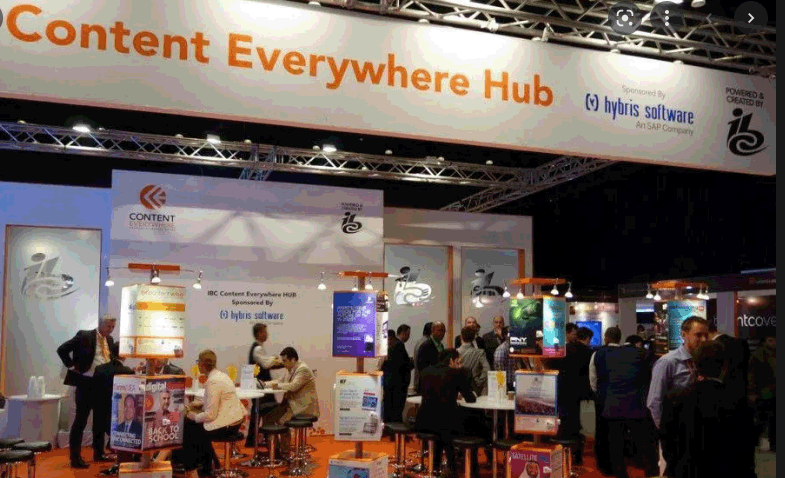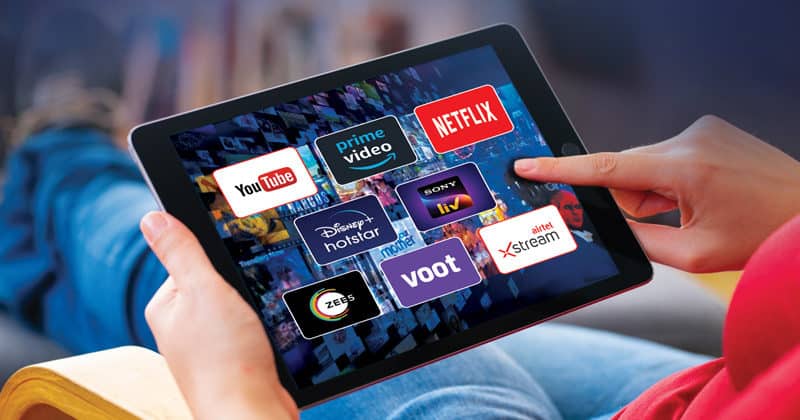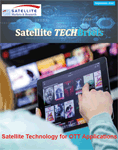The Role of Satellites in Delivering OTT Content
London, UK, September 5, 2022--After a hiatus of three years, IBC is back as an in-person event at its usual venue, the RAI in Amsterdam. The show runs September 9th – 12th. The main IBC conference takes place on the first two days only, and is centered around the theme: “What’s next? Designing the Future together,” but every day throughout the show there are multiple free sessions taking place. The latter are grouped into three themes: Innovation, Content Everywhere and Changemakers. In addition, the Showcase Theatre features a variety of presentations from exhibitors including a full day from Amazon Web Services (AWS).
This year the British Broadcasting Corporation (BBC) celebrates its first centenary. The IBC is marking this occasion by awarding the BBC the International Honour for Excellence. “Our industry, of course, has been driven forward by innovators and creators from all around the world,” said Michael Crimp, CEO of IBC. “But all of us trace the source back to those cramped rooms in Savoy Hill in London in 1922. We are pleased to present the accolade to BBC 100, but in a very real sense this award is for all of us that care about the creativity, technology and business that surrounds every practitioner in the world of media.”
In addition, an IBC Special award is being presented to a group of over 400 media and broadcast companies and individuals, who at the instigation of Sonya Chakarova (Playbox), Nero and Daniella Weigner (Cinegy) and Phillip Covell (consultant), came together to provide resources, solutions and hardware to Ukranian TV channels and media outlets to ensure they can stay on the air during the conflict. The same group also supports refugees in finding media roles across Europe.
These two awards and others will be showcased in a live-streamed ceremony on September 5th at 16.00 BST.
Content Everywhere
 “Content Everywhere” is a particular relevant theme for the satellite industry. No other technology can deliver content to all the locations that satellite can reach. However, in this particular instance “everywhere” is more a reference to over-the-top (OTT) content delivery, a segment that was initially regarded as competition, but is now being embraced, as new satellite technologies have been developed that facilitate satellite’s place in the value chain for this.
“Content Everywhere” is a particular relevant theme for the satellite industry. No other technology can deliver content to all the locations that satellite can reach. However, in this particular instance “everywhere” is more a reference to over-the-top (OTT) content delivery, a segment that was initially regarded as competition, but is now being embraced, as new satellite technologies have been developed that facilitate satellite’s place in the value chain for this.
Before delving into some detail about this, it might be useful to sort out a few acronyms for OTT streaming services, as new ones seem to be constantly emerging. SVoD, AVoD and TVoD, namely, subscription, advertising supported and transactional (e.g. a one-time purchase or rental of a movie) Video-on-Demand have been around for a while and are fairly self-explanatory.
Two new acronyms are now also being used: BVoD and FAST. BVoD refers to Broadcaster VoD, meaning a streaming service provided by a broadcaster, iPlayer from the BBC or Peacock from NBC for example. BVoD can be a free service or a subscription service. It can also be on-demand or live streaming. These services have been developed by broadcasters in order to keep their viewers and to monetize their content, in the face of increased competition from independent streaming services, such as Netflix and Hulu.
FAST refers to Free Advertising-Supported TV. This can be purely linear live-streamed channels, or more likely a combination of live-streamed and AVoD. FAST services usually include multiple channels, Pluto TV for example offers 251 channels. To complicate matters even further BVoD can also be FAST. Peacock for example, depending on where in the world you are located, offers a FAST service, an upgraded service that still includes advertising, but makes more content, including live sports available, and a premium service, SVoD service with no advertising.
Viewing Habits
 In terms of viewing habits, two things are starting to stand out. Firstly, in many parts of the world, streaming is now overtaking traditional Pay-TV, and secondly, viewers are starting to show a preference for advertising supported services, whether these be AVoD or FAST. In fact a recent report from Ofcom in the UK, indicated that 59% of viewers used FAST to live stream a program as it was being broadcast OTA.
In terms of viewing habits, two things are starting to stand out. Firstly, in many parts of the world, streaming is now overtaking traditional Pay-TV, and secondly, viewers are starting to show a preference for advertising supported services, whether these be AVoD or FAST. In fact a recent report from Ofcom in the UK, indicated that 59% of viewers used FAST to live stream a program as it was being broadcast OTA.
Research conducted at the end of last year by National Research Group for Roku in the UK, US and Canada showed that in all three countries, there are more viewers of streaming services than viewers of traditional (cable and satellite) pay TV. The Brits are in the lead, with 90% of viewers watching streamed services vs 70% traditional services. For the US and Canada the figures are 80% vs.63% and 90% vs 75% respectively. Streaming is no longer the prerogative of younger viewers. In the UK 77% of 57-70 year-olds are using streaming services and 31% of those added more services in the previous year. In the US and Canada 71% and 68% of boomers use streaming services and over 40% added more services in the previous year. The UK is leading the way with streaming of sports with 51% of users viewing sports on streaming services. In the US and Canada the figures are 42% and 33% respectively.
It is important to note that this data refers to traditional pay-TV. It does not include over-the-air (OTA) free TV, something which is generally more popular in the UK and Europe than in the US. However, the report from Ofcom, shows that in the UK, OTA viewing is very much the prerogative of the older generation, with those aged 65 and over watching, on average 5 hours and 50 minutes of OTA TV a day. In complete contrast those aged 16-24 on average spend just 53 minutes a day in front of broadcast TV. This is not to say that older people are not using streaming services. Ofcom’s data, whilst slightly lower than Roku’s, generally concurs, indicating that 83% of the population use at least one streaming service.
Viewers in all three countries are in favor of advertising supported streaming services, particularly if that means a lower monthly cost. In the UK 50% of stream ad-supported channels. Interestingly, in this respect, there is a significant discrepancy between the US and Canada, with 70% and 42% respectively, watching ad-supported streaming services. In the UK, viewers are clearly starting to become increasingly price sensitive. For the first time there has been a decline in the numbers of subscribers to at least one streaming service, with 350,000 dropping SVoD so far this year. It’s hard to imagine that viewers’ love affair with VoD will end, so this is not quite a movement to return to free broadcast television, as we all knew it before the advent of cable and satellite, but an interesting step nevertheless.
However, the high rates of inflation that many countries are experiencing at the moment, have to be taken into account when looking at consumer behavior. In the UK for example the latest data from the Office of National Statistics, put the Consumer Prices Index Including Owner Occupiers’ Housing Costs (CPIH) at 13.6% in July of this year, and a report from Citibank, indicates that this will continue to rise, peaking at 18.6% in January 2023. In Germany, the overall CPI was 7.5% in July, but some sectors such as food and non-alcoholic beverages and fuel were much higher: 14% and 35.5% respectively.
Impact on the Satellite Industry
So how does this preference for streaming video as opposed broadcast, cable and satellite services impact the satellite industry? Both SES and Eutelsat derive a significant portion of their income from video, both direct to home (DTH) and delivery to headend. SES for example delivers 8,028 TV channels to 366 Million TV homes, and revenue from this segment fell 7% in the first half of this year. 61% of Eutelsat’s revenue is derived from video, and this fell by 6.8% year-on-year in Q3. So, on the face of it, not good news. However, two other factors come into play. Firstly, as has been said many times before, there are still parts of the world where broadband to the home, cannot yet support bandwidth hungry streaming services. Secondly, whilst viewers in the more developed economies enjoy, high definition (HD) and ultra-high definition (UHD), (also referred to as 4K,) TV, that isn’t the case in everywhere. According to Euroconsult the number of HD TV channels broadcast via satellite is expected to grow by 75% by 2029, and the number of UHD TV channels is projected to grow from 166 in 2020 to over 1,100 in 2029. This translates to increased demand for satellite bandwidth.
Satellite’s role in video, however, is by no means confined to DTH or delivery to cable headends. Its role in cellular backhaul is well known, but somewhat less well known is satellite’s ability to deliver content to the edge.
As video continues to dominate both fixed and mobile traffic, the need for content delivered to the edge is growing. According to Ericsson, video will account for 76% of mobile traffic by 2025. Much of this growth is being fueled by 5G, which in addition to cellular is also being used to provide fixed wireless access (FWA), i.e. broadband to the home.
Unlike linear TV delivered by cable or satellite, streamed VoD services, mean that every time a user requests a movie or TV show an individual stream must be generated and delivered. This puts major pressure on the internet backbone. Pressure which will continue to grow as users demand more HD and UHD content. That however, may be just the beginning. Interest in more immersive experiences is growing, particularly amongst younger people. Multi-view, 360 degree view and augmented reality for example, are all possible, and all consume significantly more bandwidth than that required for UHD. Delivery of popular content to the edge, alleviates this pressure. Satellite, with its inherent “one to many” delivery capabilities is the ideal medium for this delivery.
Unsurprisingly, given the size of the opportunity, many satellite companies are developing products and solutions to facilitate delivery of video to the edge. For example, one of the many products to be showcased at IBC is SKYFlow. This has already been demonstrated by the Digital Video Broadcasting Project (DVB),and is the result of collaboration between key industry players: ST Engineering iDirect, Broadpeak, Easy Broadcast and Quadrille. SKYFlow is a flexible system that can be used to pre-position popular content at the edge for VoD, as well as to deliver live video, directly to a TV set or a set top box. Content is delivered in native IP, using generic stream encapsulation (GSE). SKYFlow can be utilized as a transmit-only system, all the way to a high performance, high bandwidth bi-directional system connecting multiple points of presence (PoPs) using a VSAT.
Satellite also has a key role to play in content creation. Not all content is shot in the studio. News and sports are obvious examples of video captured on location, but in addition many movies and TV programs incorporate scenes shot outside of the studio. Historically, large outside broadcast vans equipped with Ku-Band antennas were used for this, but their sheer size limited the locations that could be used. With the advent of 3 and 4G cellular, cellular bonding became an alternative method favored for many events. This however, has limitations. Firstly, for a major event involving hundreds of spectators, pressure on the cellular networks may be extreme, rendering the service unreliable; and secondly, cellular isn’t available everywhere. The solution is a smart network combining cellular and satellite and seamlessly switching between them to provide a constant, reliable pathway for transmitting video, back to the studio or to a public or private cloud. This was recently demonstrated by Dejero, utilizing a Newtec Dialog Hub for a video shoot in the Canadian Rockies.
Cloud Connectivity
Cloud connectivity is becoming increasingly important, in part spurred by Covid as working from home became the norm. Nowhere is cloud connectivity more important than in content creation. Loading video being shot on location into the cloud, means that the sound and video editors can work together wherever they happen to be physically located. Satellite companies and Cloud providers alike were not slow to grasp this opportunity and form alliances. SES, for example, expanded its existing alliance with Microsoft Azure to include O3b mPOWER its second generation MEO constellation. Speedcast is an AWS partner, SpaceX has a deal with Google Cloud for Starlink, its LEO constellation and Telesat is working with CloudOps to develop a hybrid cloud platform for its LEO constellation.
Conclusion
Once upon a time, satellite was used for long-distance telephony, then for video content delivery for OTA television, then to cable headends, then direct-to-home. The evolution continues, as satellite takes its place in the streaming revolution.
Related Article:
 Read the a TECHBrief report on the Satellite Technology for OTT Applications sponsored by ST Engineering iDirect
Read the a TECHBrief report on the Satellite Technology for OTT Applications sponsored by ST Engineering iDirect
--------------------------------------------
 Elisabeth Tweedie has over 20 years experience at the cutting edge of new communications entertainment technologies. She is the founder and President of Definitive Direction (www.definitivedirection.com), a consultancy that focuses on researching and evaluating the long-term potential for new ventures, initiating their development, and identifying and developing appropriate alliances. During her 10 years at Hughes Electronics, she worked on every acquisition and new business that the company considered during her time there. She can be reached at etweedie@definitivedirection.com
Elisabeth Tweedie has over 20 years experience at the cutting edge of new communications entertainment technologies. She is the founder and President of Definitive Direction (www.definitivedirection.com), a consultancy that focuses on researching and evaluating the long-term potential for new ventures, initiating their development, and identifying and developing appropriate alliances. During her 10 years at Hughes Electronics, she worked on every acquisition and new business that the company considered during her time there. She can be reached at etweedie@definitivedirection.com





